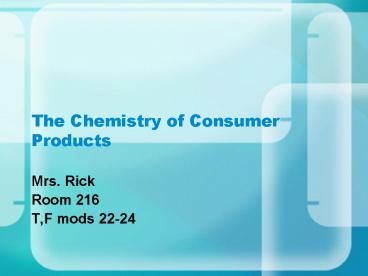The Chemistry of Consumer Products - PowerPoint PPT Presentation
1 / 22
Title:
The Chemistry of Consumer Products
Description:
Calcium. Magnesium. Mercury. Water. Solutions. A ... Chloride ion. Calcium / Magnesium ion. Water. Analysis for available oxygen ... Analysis for Chloride Ion ... – PowerPoint PPT presentation
Number of Views:212
Avg rating:3.0/5.0
Title: The Chemistry of Consumer Products
1
The Chemistry of Consumer Products
- Mrs. Rick
- Room 216
- T,F mods 22-24
2
Course Outline
- Water
- Surfactants
- Detergents
- Skin cleansing / Protection
- Fragrances
- Foods
3
Course Responsibilities
- Attendance / participation
- Activities
- Exam
4
Water
- Water is one of the most abundant resources on
Earth. - How is water used?
5
Water Use
6
Water
- Where does the water we use come from?
- Hydrologic Cycle
7
Water
- Distribution of the Earths Water supply
- Rivers 0.0001
- Atmospheric Moisture 0.001
- Lakes 0.009
- Ground Water 0.62
- Glaciers and Ice Caps 2.11
- Ocean Water 97.2
8
(No Transcript)
9
Water
- Typical contaminants
- Soot
- SO2
- CO2
- Iron
- Chlorine
- Calcium
- Magnesium
- Mercury
10
Water
- Solutions
- A mixture that is completely uniform throughout
- Suspension
- Contain relatively large, easily seen particles
- Colliods
11
Water
- Colloids
- In colloidal suspensions the particles are much
larger than the solutes in a solution. - For solutions, ions and molecules have a size of
about 10-7 cm. - In colloids, the particles are larger, with sizes
from 10-7 to 10-5 cm. - The colloidal particles are still to small to
settle out due to gravity.
12
Water
Tyndall Effect
13
Water
14
Water
- Primary factors affecting water quality
- pH
- Dissolved ions
- Heavy Metals
- Pb, Hg, Cd
- Organics
15
Water
- Purification
- Distillation / Condensation
- Bacterial Action
- Filtration
- Chemical Treatment
- Hard Water
- Permanent Hardness
- Temporary Hardness
16
Water Hardness
17
Water
- Most regions of the US have relatively soft
water. - Most European countries have water with permanent
hardness averaging 320 ppm!
18
Water Analysis
- Available Oxygen
- Chloride ion
- Calcium / Magnesium ion
19
Water
- Analysis for available oxygen
- Measured by adding KI and H2SO4 to sample.
- Iodide ions will reduce any available oxygen and
be reduced to elemental I2
20
Water
- Cont.
- Elemental iodine is then titrated with sodium
thiosulfate. - I2 2S2O32- ? 2I- S4O62-
- Disappearance of brown iodine color gives
endpoint. (Starch used for added clarity)
21
Water
- Analysis for Chloride Ion
- Small amount of NaCrO4 is added, and water sample
is titrated with AgNO3. - AgCl precipitates (cloudy white) until all Cl-
is used, then AgCrO4 forms (bright red)
22
Water
- Determination of Water Hardness.

